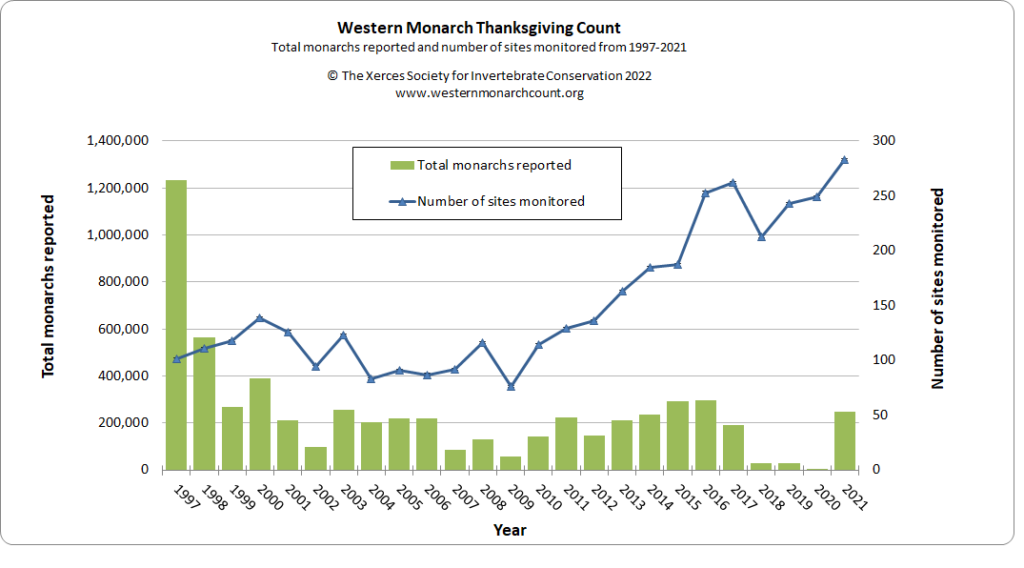The western monarch population saw an extraordinary rebound in 2021, according to overwintering count totals recently released by the Xerces Society. The 2021 Western Monarch Thanksgiving Count tallied 247,237 monarchs, a significant increase from the previous year’s count, which came in at just under 2,000. The 2021 count is the highest tally since 2016 and an encouraging indication that monarchs can bounce back from direly low numbers if conditions are right.

The annual Western Monarch Thanksgiving Count surveyed 283 overwintering sites, the most sites ever surveyed in one year. Santa Barbara County reported the most monarchs at just over 95,000, while San Luis Obispo County tallied the second most monarchs with over 90,000 butterflies reported. According to Xerces Society, more monarchs were recorded at some of the more southern overwintering sites than has been observed in recent years. For example, Ventura and Los Angeles counties totaled nearly 19,500 and over 4,000 butterflies respectively, numbers that have not been seen in those areas in nearly 20 years. Due to the astounding rebound of monarchs this year, there is considerable uncertainty as to whether most of the butterflies were counted last year and in previous years. This is not surprising due to the mobility of the species and our limited understanding of their movement. Chip Taylor, director of Monarch Watch, hypothesizes that there may be overwintering sites that have gone unaccounted for in recent years.
“So, how can we explain the difference in the overwintering numbers from 2020 to 2021? Two things seem unlikely. It doesn’t seem possible that the few hundred females that survived from last year’s overwintering population could account for over 200,000 monarchs this year. Nor is there any evidence that monarchs arrived in the inner West in March and April from Mexico. That leaves us with the possibility that there were unfound overwintering sites with thousands, perhaps 10’s of thousands of monarchs, and the possibility that offspring of coastal breeding monarchs moved inland and generated a first generation that colonized the breeding areas in the inner West and the northwestern states,” writes Taylor.
Western monarchs breed west of the Rocky Mountains and overwinter primarily along the Pacific Coast. The much larger eastern population overwinters in the oyamel fir forests of central Mexico, with those tallies expected to be available in the coming weeks. One complication for monarch conservation and protection under the Endangered Species Act is that the overall status of monarchs globally is evaluated vs. each individual sub-population. The eastern and western populations each face unique conservation challenges, so we must continue to address the needs of both to ensure they recover to sustainable population levels.
While the 2021 rebound is encouraging, conservation and pollinator habitat efforts must continue to be strengthened to sustain monarch population increases. Farmers for Monarchs aims to identify agricultural and conservation practices that support healthy monarch populations and increase awareness of those practices among all stakeholders. Just as the eastern monarch population relies heavily upon the agricultural Midwest as a productive breeding area, the western population relies heavily upon early spring breeding in the agricultural Central Valley of California. It takes a concerted effort from all sectors, including the agriculture community, to plant, enhance, and protect forage to revive pollinator populations. Below is a list of government and non-government organizations, programs, and resources offered to help California farmers and ranchers establish pollinator habitat:
- The U.S. Department of Agriculture
- Practice 327A, Conservation Cover, Pollinators
- Practice 422A, Hedgerow Planting, Pollinators
- The Environmental Quality Incentive Program (EQIP)
- The Agricultural Conservation Easement Program (ACEP)
- The Conservation Stewardship Program (CSP)
- The Conservation Reserve Program (CRP)
- The U.S. Fish and Wildlife Service
- California Department of Food and Agriculture
- California Association of Resource Conservation Districts
- Monarch Joint Venture
- Project Apis m. Seeds for Bees cover crop program
- Environmental Defense Fund
- Xerces Society
- Pollinator Partnership
You can get more information on these and other resources by visiting the State Planting Resources page on our website. You can also contact the Monarch Joint Venture’s Pollinator Habitat Help Desk at (337) 422-4828 or (337) HABITAT for more information on planting milkweed and other pollinator habitat on your land.
